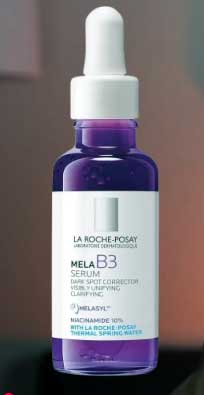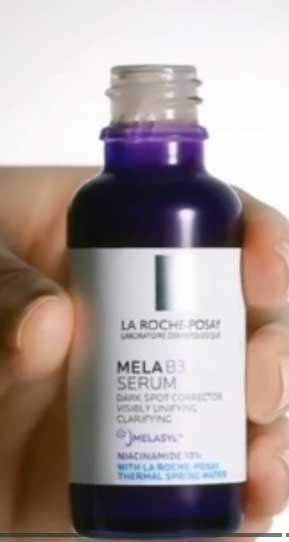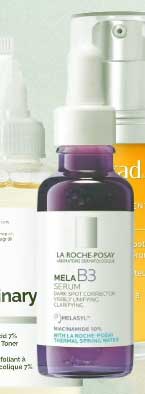I’ve tried everything for my stubborn dark spots—vitamin C, retinol, hydroquinone, you name it. When I heard about La Roche-Posay’s new Mela B3 serum, I was skeptical but desperate. If you’re like me, tired of marks that just won’t fade, this review is for you.
This serum, with its patented Melasyl, is designed for those of us who need real, visible change, not just empty promises. It’s for you if you’re ready to finally tackle discoloration at its source, and you’re willing to put in the work to see it through.
My Experience With La Roche Posay Mela B3 Dark Spot Serum

Let me set the scene for you. My main enemies were a cluster of sunspots on my left cheekbone that have been there for years, and a newer, very angry purple-red post-acne mark on my chin that refused to budge.
I’m diligent with my routine, but these spots were squatters, and they were not paying rent.
I bought the Mela B3 serum the week it launched, drawn in by the clinical-looking purple bottle and the promise of this new, 18-years-in-the-making ingredient called “Melasyl.”
The first time I used it, I was immediately impressed by the texture. It’s a lightweight, almost milky gel-serum. It’s not watery and thin, but it’s not thick or oily, either.
It has this incredible slip to it and sinks in within about 30 seconds. I applied three drops, which was plenty for my face and neck. It has a light, clean, floral scent—more on that later—but it didn’t sting or tingle, which I half-expected from a 10% Niacinamide formula. Most importantly, it played perfectly with my other products. It didn’t pill under my moisturizer or, crucially, under my morning sunscreen. This is a huge deal for me, as a pilling serum is a dealbreaker.
I used it religiously, morning and night, after cleansing. For the first two weeks, I’ll be honest: nothing. I saw no change. My skin felt hydrated and maybe a little brighter, but my spots were still there, mocking me. I was getting frustrated, but I’d promised myself I’d use the whole bottle.
Then, around week three, I noticed the post-acne mark on my chin. The angry purple-red hue had softened to a lighter, pinkish-brown. It was the first sign of hope. By week six, that new spot was almost entirely gone, just a faint shadow of its former self. But what about the stubborn sunspots? Those took longer. I’m now at the end of my second bottle, so about 10 weeks in. The sunspot cluster on my cheek is noticeably broken up. It’s not gone—I don’t think any topical serum can fully erase decade-old sun damage—but it is significantly lighter, less defined, and easier to cover with concealer. My overall skin tone is more even and has a clarity it lacked before. This wasn’t a miracle; it was a slow, steady march, but it was the first time I saw real progress on those old spots.
Also read: My Thoughts on Redness Defense Green Primer
Pros Of La Roche Posay Mela B3 Dark Spot Serum
- The Melasyl + Niacinamide Power Couple: This isn’t just another niacinamide serum. The star here is Melasyl, L’Oréal’s new patented ingredient. From my analytical perspective, this is the key differentiator. While ingredients like Vitamin C, retinol, and hydroquinone work by inhibiting tyrosinase (the enzyme that produces melanin) or increasing cell turnover, Melasyl works differently. It’s designed to be a “melanin trapper.” It catches the melanin precursors before they can even deposit in the skin and form a visible dark spot. It’s proactive, not just reactive. When you pair this new-school “interceptor” with 10% Niacinamide—a well-researched, reliable workhorse that fades existing spots, calms inflammation, and strengthens the skin barrier—you get a truly comprehensive, multi-pathway approach to fighting hyperpigmentation. You’re cleaning up old messes and preventing new ones at the same time.
- Superior Texture And Cosmetic Elegance: I cannot overstate this. The reason most people fail to see results from a hyperpigmentation serum is that they stop using it. Why? Because the texture is sticky, tacky, oily, or it pills under makeup and sunscreen. This Mela B3 serum is a dream to use. It’s an opalescent, lightweight gel that glides onto the skin and absorbs in under a minute, leaving a smooth, hydrated, slightly plump finish. It creates a perfect canvas for your next steps. I’ve layered it under thick creams, gel moisturizers, and four different sunscreens (both mineral and chemical) without a single instance of pilling or weird texture. This high-level cosmetic elegance makes you want to use it twice a day, every day, which is the only way you’ll ever get the results you’re paying for.

- Formulated For (Most) Sensitive Skin: La Roche-Posay’s entire brand identity is built on its thermal spring water and its “sensitive skin-approved” formulations. While 10% Niacinamide can be a lot for some people, this formula feels remarkably gentle. I have reactive skin that flushes easily, and I experienced zero stinging, burning, or redness. It actually feels soothing upon application. It’s also non-comedogenic, so it didn’t clog my pores or contribute to the very acne that causes my post-acne marks in the first place. For those who find active ingredients like glycolic acid or high-potency retinoids too harsh, this serum offers a powerful alternative that respects the skin barrier.
- Efficacy On Multiple Types Of Hyperpigmentation: This is a crucial pro. My skin isn’t a one-trick pony; I have different types of spots. I’ve got post-inflammatory hyperpigmentation (PIH) from acne, which shows up as red or purple marks. I’ve also got solar lentigines (sunspots) from years of, well, living, which are brown and more stubborn. This serum worked on both. It cleared my newer PIH marks on my chin in about six weeks. It took much longer (10+ weeks) to make a dent in my older sunspots, but it did make a dent, breaking up the pigment and fading the edges. Many serums are only good for one or the other. Vitamin C is great for overall brightening but often fails on deep, stubborn spots. This serum feels like an all-in-one discoloration solution.
Cons Of La Roche Posay Mela B3 Dark Spot Serum
- The Price Is A Serious Investment: Let’s get the most obvious con out of the way. This serum is not cheap. It sits at the very top end of the drugstore price range, competing directly with premium and “derm” brands you’d find at a specialty beauty store. You’re paying for the 18 years of research and development that went into the patented Melasyl ingredient. For a 30ml (1 oz) bottle, this is a significant recurring cost, especially since you’ll be using it twice a day. If you’re on a tight budget, there are definitely more affordable niacinamide or alpha arbutin serums out there. You have to decide if the advanced technology and faster results (which I did experience) are worth the premium price tag. For many, this cost will be a major barrier to entry.
- Patience Is Not Optional, It’s Required: The marketing on the box might show impressive results in a few weeks, and for new spots, that’s somewhat accurate. But if you are buying this for deep, stubborn, set-in dark spots or melasma, you must manage your expectations. I’m talking about 8 to 12 weeks of consistent, twice-a-day use before you see significant fading. I almost gave up at week two. Many people will use it for a month, see minimal change in their old spots, and declare it a failure. This serum does not offer overnight results. It’s a long-term commitment, and if you don’t have the patience to see it through an entire bottle (or two), you will be wasting your money.
- The Fragrance Is A Baffling Choice: For a brand that stakes its entire reputation on being the gold standard for sensitive skin, the inclusion of fragrance (Parfum) in this serum is a genuinely confusing decision. The scent itself is light, pleasant, and “clean”—it didn’t bother me personally. However, fragrance is one of the most common contact allergens and irritants in all of skincare. For anyone with rosacea, eczema, or compromised skin barriers, the fragrance could be a dealbreaker and a potential source of irritation, which is the last thing you want when you’re already dealing with inflammatory hyperpigmentation. They should have made this fragrance-free, full stop.
- Potential For Irritation At 10% Niacinamide: While I tolerated it well, 10% Niacinamide is a very potent, active dose. It is not a beginner’s ingredient. If your skin is not accustomed to high-dose niacinamide, you can absolutely experience irritation, flushing, itching, and even purging (breakouts) when you first start. This isn’t a flaw in the product so much as the nature of the active ingredient. People who jump right into twice-a-day use with “virgin” skin might irritate their barrier, leading them to believe the serum is “bad” when, in reality, they just needed to introduce it much more slowly.
Maintenance Tips For La Roche Posay Mela B3 Dark Spot Serum

- Sunscreen Is The Serum’s Non-Negotiable Partner: I cannot, cannot stress this enough. If you use this serum (or any dark spot corrector) and do not wear a broad-spectrum SPF 30 (preferably SPF 50) sunscreen every single morning, you are throwing your money directly into a fire. You are trying to empty a bucket that has a giant hole in the bottom. The sun is the primary driver of hyperpigmentation. Using this serum makes your skin work hard to clear pigment, and then walking outside without protection invites all that pigment (and more) to come right back. Your results will be completely undone. This serum must be part of a system, and sunscreen is the most important part of that system. Reapply it. Love it. Marry it.
- Consistency Is Infinitely More Important Than Quantity: You might be tempted to slather this on, thinking more serum means faster results. That is not how this works. All you’ll do is waste product and increase your risk of irritation. All you need is 3-4 drops for your entire face and neck. The real secret is not how much you use, but how often you use it. You must be diligent. This means morning and night, every single day, without fail. Skipping days, especially in the first two months, will dramatically slow your progress. It’s the slow, steady, twice-daily application that allows the Melasyl and Niacinamide to continuously work on the pigment cycle. It’s a marathon, not a sprint.
- Start Slow If You Are A Niacinamide Newbie: Because this contains a high 10% concentration of Niacinamide, you need to respect it. If you’ve never used Niacinamide before, or you’re coming from a 2% or 5% formula, do not jump into using this twice a day. You risk overwhelming your skin and damaging your moisture barrier. A damaged barrier will only lead to more inflammation and spots. Instead, start by using it only once a day (in the evening) for the first week. If your skin feels fine, move to once a day every day. After two weeks of no irritation, you can then try introducing it in the morning as well. Listen to your skin. A little tingling is one thing; burning, itching, or redness means you need to back off.
- Layer Your Routine Correctly For Maximum Impact: Where this goes in your routine matters. You want it as close to your clean skin as possible to ensure the active ingredients can penetrate effectively. The general rule is to apply products from thinnest to thickest. So, your routine should be: Cleanser, Toner (if you use one), then your Mela B3 serum. Let it absorb for a full 60 seconds. Then you can apply your other serums (like hyaluronic acid), your moisturizer, and (in the AM) your sunscreen. Don’t cocktail it in your hand with other products; apply it in its own step. Also, be careful about pairing it in the exact same routine with other strong actives like glycolic acid or retinoids, especially at first. You can alternate (e.g., Mela B3 in the AM, retinol in the PM) to get the benefits of both without overwhelming your skin.
Comparison With Other Brands
- Versus The Original LRP Pure Niacinamide 10 Serum: This is the most logical comparison—an internal battle. The Pure Niacinamide 10 was La Roche-Posay’s previous reigning dark spot serum. Mela B3 is its direct replacement and upgrade. The old formula was fantastic for general brightening and barrier support, but its main (and only) active for spots was Niacinamide. Mela B3 takes that same 10% Niacinamide base and adds the new, patented Melasyl. In my opinion, this makes the old serum obsolete. The Mela B3 is formulated to be more powerful and to work on a different pigment pathway. If you liked the Niacinamide 10, you will love this. If you were underwhelmed by the Niacinamide 10’s effect on stubborn spots, the Mela B3 is the one you should be trying.
- Versus Caudalie Vinoperfect Radiance Serum: This is the classic “clean beauty” champion. The Caudalie serum uses Viniferine, an ingredient derived from grapevine sap, which they claim is 62 times more effective than Vitamin C. It’s a beautiful, milky serum that smells incredible and is fantastic for overall brightening and giving your skin a “glow.” I’ve used it, and it’s lovely. However, I find it’s much gentler and works far more slowly on existing dark spots. The Caudalie serum is what I’d recommend for preventing pigmentation and achieving a radiant complexion. The La Roche-Posay Mela B3 is what I recommend for an active attack on stubborn, set-in spots. The LRP feels more clinical and potent, while the Caudalie feels more like a luxurious preventative and brightening treatment.
- Versus Topicals Faded Serum: This is the internet cult favorite, and for good reason. Faded is a powerhouse that uses a cocktail of tranexamic acid, azelaic acid, niacinamide, and kojic acid. There is no denying that Faded works—it’s incredibly effective, especially on post-acne marks. The main difference? Cosmetic elegance. The original Faded is infamous for its pungent, sulfur-like smell (though they now offer an unscented version). It’s also a thicker, cream-like texture that some find difficult to layer. The Mela B3, by contrast, is a sleek, lightweight, pleasantly-scented serum that sinks in immediately. If you want pure, brute-force effectiveness and don’t care about the smell or texture, Faded is a top contender. If you want a product that is both highly effective and a genuine pleasure to use, the Mela B3 wins hands-down.
Read more: My Thoughts on Palmer’s Skin Success Eventone Fade Cream
Frequently Asked Questions (FAQ)
Yes, in my experience, it absolutely does work. However, it’s not an overnight miracle. It works exceptionally well on new and emerging dark spots (like post-acne marks), fading them in a matter of weeks. For older, more stubborn sunspots, it takes much longer (2-3 months) to see significant fading, but it does visibly break up and lighten the pigment.
You will likely notice an overall brightening effect and fading of new spots within 2 to 4 weeks. For more persistent, set-in dark spots and sun damage, you must be patient. You should commit to using it twice a day for at least 8 to 12 weeks to see significant, measurable results.
Yes, the product is designed to be used every day, and even twice a day (morning and evening), for best results. However, because it contains 10% Niacinamide, I recommend patch-testing first. If you have very sensitive skin or are new to niacinamide, you might want to start by using it only once a day for a week or two to let your skin acclimatize before moving to twice-daily use.
The primary benefits are twofold. First, it corrects existing dark spots (including sunspots, age spots, and post-acne marks) using 10% Niacinamide. Second, it helps prevent new spots from forming by using the new, patented Melasyl ingredient to intercept excess melanin before it marks the skin. Secondary benefits include strengthening the skin’s moisture barrier, calming inflammation, and providing a more even, radiant overall skin tone.
Conclusion
So, is the La Roche-Posay Mela B3 serum worth it? For me, the answer is a resounding yes. It’s not a magic eraser, and it’s certainly not cheap, but it’s the first product that has made a real, visible dent in my most stubborn, long-term dark spots.
If you’re frustrated with pigmentation that just won’t budge and you are willing to be patient and absolutely diligent with your sunscreen, this serum is worth the investment. It’s the clinical-grade-at-home powerhouse that many of us have been waiting for.
